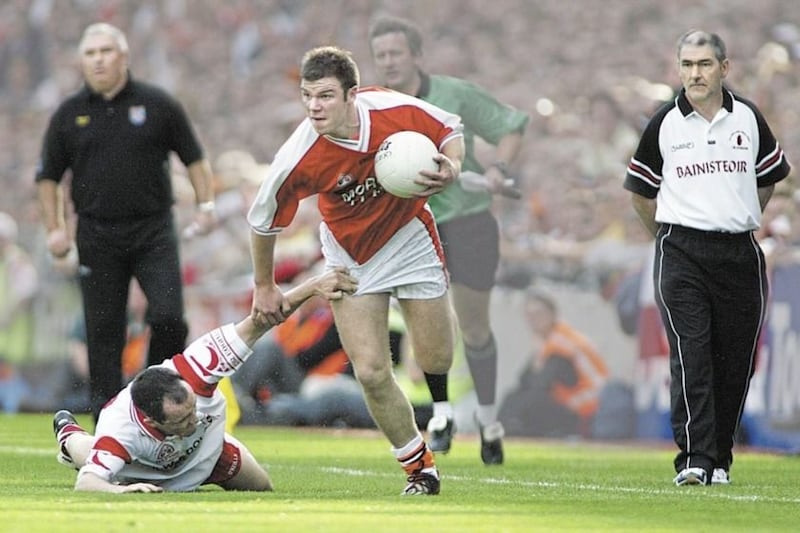Rather like Alanis Morrisette all those years, I don't really know what is and isn't ironic any more. However, it was certainly frustrating that internet issues played a part in my not seeing Colin Trainor's data-based analysis of Donegal-Tyrone until I returned to Belfast from Ballybofey.
Having interviewed Armagh man Trainor about his insights into the GAA, I could have, er, shall we say 'paid homage' (but not money) to him in assessing why the hosts were too strong for the Red Hands.
No newspaper report can capture every element of any match but this reporter always thinks on the way home about those aspects which he didn't include, either through choice, lack of space, forgetfulness, or rank incompetence.
Data-driven analyses of the GAA has become increasingly prevalent, but Trainor's seem to me more immediate and useful than many.
His rapid adeptness at showing 'the story of the match' with eye-catching graphic detail is a step on from mere bar charts or collections of numbers.
I'm a strange mix of old school with a fondness for the not necessarily necessary new-fangled (a word which merely reinforces my old school tendencies). You know, I like earphones made partly out of wood or a titanium coffee spoon, that sort of thing.
Yet for all my own interest in numbers and statistics, as far as I'm concerned, the winning and losing of matches, in most sports, still largely comes down to the making and taking of chances – and the stopping or dropping of them.
The latter-day obsession with kick-outs only matters to the extent of how much more (or less) possession they give a team; what's more important is what they do with the ball.
Wide counts are obviously more important, especially if you factor shots dropped short into a 'wasted chances' tally.
For illustration, Team A could win 30 kick-outs compared to 20 for Team B – but if Team A wastes half the 20 chances for point it creates and attempts, while Team B takes 12 of the 16 opportunities it carves out, then Team B will win by 12 points to 10.
Obviously a 75 per cent shot conversion ratio is far better than 50 per cent.
Believe me or not, I wrote those words before checking Colin's Twitter feed further – and seeing that, on Saturday, Monaghan had 30 kick-out possessions while Kerry only got the ball 15 times from kick-outs; but the Kingdom scored 0-9 from those while the hosts only managed 0-8.
Clearly this was just one match, and such a disparity in kick-out stats, especially to the detriment of the victors, is probably rather rare.
However, when the numbers showed that winning so many kick-outs didn't help Monaghan overall, Trainor knew to look elsewhere to explain why they lost.
Other factors contributing to the three-point away win included Kerry losing the ball less to turnovers, a consequence of good defensive play by the Kingdom and poor passing by Monaghan.
The analysis that Trainor and others like him are offering provides other insights, such as into likely scoring zones. He noted that Donegal forced Tyrone to shoot from wider areas, reducing their scoring return from open play.
Also apparent to him from his stats was that Mayo hammered Galway because they were able to shoot from far closer range than is normally the case – just over 22 metres, compared to 26m for their opponents. To put the openness of that match into context, Kerry's average shot distance was more than 28m, Monaghan's almost 29, Tyrone's close to 32, and Donegal's 32.4 – which also indicates the quality of long range shooting from Declan Bonner's men.
Sure, it was clear to all observers, either in the ground or watching on TV, that Donegal's shooting was better than Tyrone's, and that the latter were also worse off in terms of winning their own kick-outs. And that did matter – Donegal scored 1-12 from kick-out possession, Tyrone only 0-8.
Yet Trainor was also able to quickly point out that the Red Hands had forced more turnovers, and that their ball-handling was better than Donegal's, elements which weren't immediately obvious, at least not to this observer. Tyrone attacked more but were less clinical.
He was also able to provide other interesting info, such as that average distance from which players tried to kick a score.
Even so, the wealth of information available in soccer is nowhere near matched by Gaelic games.
I'd like to have APOP at players, but not necessarily in a negative way – that's 'Average Position On Pitch'. That information has been widely available in soccer for a few years, and is a clear indicator of a team's approach, their 'shape' – attacking, defensive, stronger on one flank or the other, etc. It's even being shown during live Bundesliga coverage now.
In Gaelic football it would show similar things, not least indicating where some players actually played, which often can be rather hard to discern.
'Heat maps', showing the area a player covered, coloured an increasingly bright red where they were most active, are a variant of that.
Of course, it's likely that counties – at least the richer ones – already have access to much more information than appears in the public domain.
Player tracking data from the devices stuck into the 'sports bras' you see when player peels off his jersey post-match could contribute to APOP or heat maps.
Yet the GAA has barely reached adulthood in terms even of statistical record-keeping. Great work has been done, and continues to be done, by incredibly dedicated and devoted amateurs, including county PROs and club historians - but collating and checking such information is still a piecemeal exercise.
So it's still a pipe dream to hope that extensive data about GAA games will be widely available any time soon.
For now, we'll have to rely on industrious, intelligent enthusiasts. Every team has a trainer, but they could also really benefit from a Trainor.







